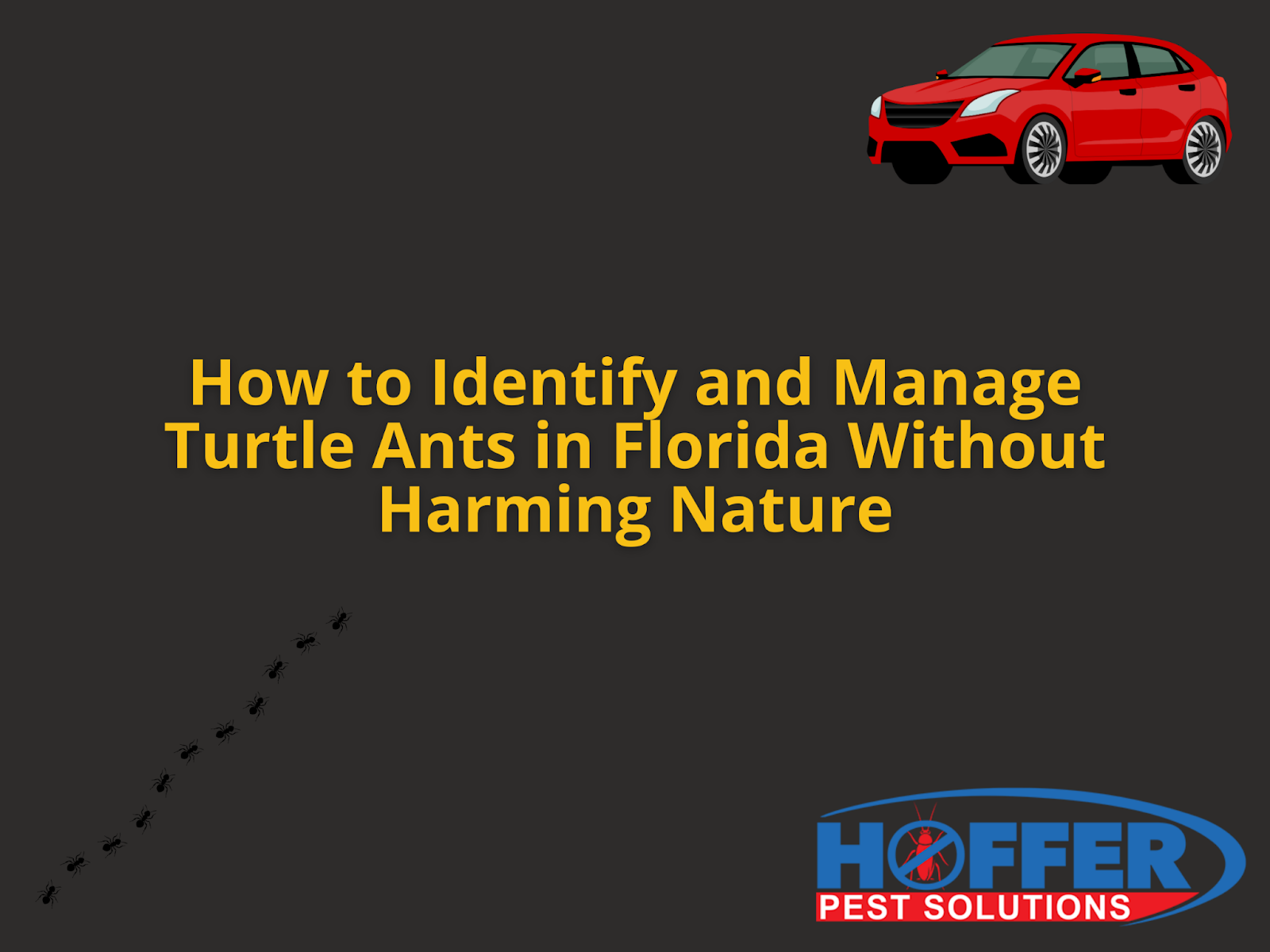Turtle ants are a native part of Florida’s forest canopy and are increasingly spotted in suburban yards, especially after storms. While they’re becoming more noticeable, they remain uncommon and misunderstood by most homeowners.

Key Facts About Turtle Ants in Florida:
Recognizable by their flat, shield-like heads used to block nest entrances.
Arboreal: they nest in hollow branches, not in soil or homes.
Sightings often increase after storms disturb tree limbs or fallen wood.
Non-aggressive: they don’t bite, sting, or damage structures.
Ecologically important, contributing to nutrient cycles in forest ecosystems.
If you’re seeing strange ants with “turtle shells” on their heads, don’t panic. At Hoffer Pest Solutions, we understand the difference between pests and beneficial species, and we offer guidance that’s both effective and environmentally responsible.
Keep reading to discover how to identify turtle ants properly, what to do if they show up in your yard, and how to manage all Florida ants without harming the ecosystem.
What Are Turtle Ants and Why Are They Showing Up in Florida?
Turtle ants, scientifically known as Cephalotes, are a fascinating and unusual group of ants that are increasingly being noticed across Florida. These ants are known for their unique flat-headed appearance and their preference for living in trees rather than on or beneath the ground.
Unlike the aggressive or invasive ant species that commonly appear in homes, turtle ants live high above in the canopy, navigating branches and twigs with precision.
In recent years, residents in Florida have reported spotting these peculiar ants more often, particularly in backyards filled with old trees or near wooded areas.
How to Identify Turtle Ants in Florida
Turtle ants can be tricky to spot, especially if you’re not familiar with their appearance. However, there are several features that make them stand out once you know what to look for.
The most distinctive trait is their head. Turtle ants, particularly the soldier caste, have a broad, flat, disc-like head that almost looks like a shield. This unique head shape is not just for protection, it’s used to block the entrances of their nests, acting as a living door to keep out intruders. This architectural behavior is one of the most recognizable signs that you’re looking at a turtle ant colony.
Their bodies are generally dull brown or black, which helps them blend in with the bark and twigs of trees. This camouflage makes them hard to spot unless you’re actively looking for movement or are very close to their nesting sites. Despite their exotic appearance, they are relatively small and often overlooked by casual observers.
Turtle ants are almost always found above ground. They live in hollow branches, twigs, or even inside old fence posts, but not in soil or under rocks. This is a key difference from ground-dwelling ants like fire ants or pavement ants.
Most turtle ants are active during the day, slowly moving along tree trunks and branches. However, some species may have nocturnal mating flights or other nighttime behaviors, which can add to the confusion when trying to identify them.
Where Turtle Ants Live (And Why They’re in Your Yard)
Turtle ants have a very specific preference when it comes to their nesting environment. Unlike typical ants that burrow into the ground, turtle ants live almost exclusively in trees. Their nests are usually found inside hollow twigs, beetle-bored wood, or natural cavities in branches. These ready-made spaces allow the colony to establish itself without the need to excavate, making them perfectly suited for an arboreal lifestyle.
In Florida, turtle ants tend to be more common in areas with dense vegetation. You’re more likely to find them in forested backyards, wooded parks, or near coastal dune ecosystems where fallen branches and tree diversity create natural nesting opportunities. The Florida climate, with its year-round warmth and high humidity, provides ideal conditions for turtle ants to remain active and for their colonies to thrive.
It’s not unusual to see turtle ants after strong storms. High winds or heavy rain can knock down branches or damage trees, exposing hidden nests. If you’ve recently cleaned up yard debris or trimmed tree limbs, you may suddenly notice ants with strange, flat heads appearing nearby. That doesn’t mean they’ve moved into your home, it just means you’ve come closer to their natural habitat.
Are Turtle Ants Dangerous?
Turtle ants may look unusual, but they are not dangerous.
They do not bite, sting, or carry any known health risks to humans or pets. Unlike fire ants or carpenter ants, they are not aggressive and are unlikely to defend themselves unless physically disturbed. Their primary response to threats is to retreat or block entry points using their shield-like heads.
From a pest control perspective, turtle ants are generally not considered a problem.
Most professionals do not treat them as pests because they do not cause structural damage, contaminate food, or form invasive ground colonies. Their presence is more ecological than economic. In fact, their role in forest ecosystems includes occupying dead wood, interacting with other insects, and contributing to nutrient cycling in trees.
For the average homeowner, turtle ants are more of a curiosity than a threat.
They don’t infest homes like carpenter ants, which tunnel through wood, or fire ants, which build aggressive mounds and sting intruders. If you do encounter turtle ants, there’s usually no cause for alarm. Their appearance in your yard is likely the result of proximity to a mature tree canopy or disturbed vegetation, not a sign of infestation.
Not Every Ant Is a Threat, But We’re Here If It Is
Turtle ants are harmless, tree-dwelling natives that usually don’t need intervention. They rarely enter homes and play a valuable role in Florida’s ecosystems. In most cases, the best response is simple observation and prevention, no pesticides required.
If you’re unsure whether you’re seeing turtle ants or something more destructive, Hoffer Pest Solutions can help. Our experts specialize in identifying native species and offering eco-friendly solutions that protect your home without harming beneficial wildlife.


